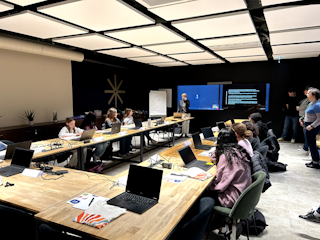The exact number of individuals identifying as transgender, non-binary or gender fluid in Switzerland is not known, although several reports make various estimates at the numbers. TGNS (Transgender Network Switzerland) estimates from various studies this number to be anywhere between 0.3 to 8.4% of the population. In contemporary use, non-binary is both a specific gender identity as well as an umbrella term for a variety of gender identities and expressions that fall outside of the man/woman binary.
People who are transgender may pursue multiple domains of gender affirmation, including:
-
Social affirmation (e.g., changing one’s name and pronouns)
-
Legal affirmation (e.g., changing gender markers on one’s government-issued documents)
-
Medical affirmation
-
Surgical affirmation
Not all people who are transgender, however, will desire all domains of gender affirmation, as these are highly personal and individual decisions. Furthermore, this view of focus only notes transgender individuals who identify and affirm their gender to the traditional binary system. Beyond this demographic, there is an increasing number of individuals — notably, there is a higher percentage reported within the Gen Z population than Millennial or Boomer demographics — identifying as non-binary as culturally the concept of gender becomes more fluid.
Many employers have adapted over the last decade to support their LGB (lesbian, gay, bisexual and queer) workforce but have not managed to understand or extend their knowledge to support the T (transgender) workforce.
Employers remain ill equipped and uninformed of the struggles of their trans, non-binary and gender fluid workers face and are therefore unable to provide support. As employers, understanding that movement is required now, with a new generation entering the workforce, in a post-pandemic world where culture trumps other benefits.
Keep up or get left behind
For most of us, depending on the day, work can be stressful. Various studies suggest between 18-60% of Swiss workers are suffering from workplace-related stress and even emotional exhaustion.
Imagine on top of that stress having to suppress — or feeling like you need to hide or suppress — who you are, your gender identity, because it does not conform to your company’s or societal norms relating to gender expression.
For many transgender, non-binary and gender fluid people, this is the experience they live with every day, juggling their work life whilst masking their true selves due to fear of ostracization, rejection or mobbing, with some also at the same time juggling with mental health illness.
While trans awareness is increasing, and laws changing within Switzerland, and somewhat for non-binary people, too, non-binary genders have not yet gained widespread societal acceptance, and as a result, non-binary people are frequently experiencing identity invalidation.
Within Switzerland in 2023, the number of LGBT attacks doubled, as reported by TGNS. An assumption may therefore be made that unless your workplace holds high levels of psychological safety, rigid support mechanisms or inclusion maturity, your trans, non-binary and gender fluid team members are not able to bring their full selves to work. Further, it can be assumed that there is inequality within your workplace, a high likelihood that mental illness is present, and that your workforce is not thriving or therefore performing to its true potential.
Many individuals experiencing gender dysphoria or identifying as transgender, gender fluid or non-binary may experience often misgendering within the workplace, which over an extended period of time will have detrimental effects on that person’s health.
Misgendering may take the form of intentional or unintentional “deadnaming,” using that person’s name they were assigned at birth but no longer identify with or using incorrect pronouns.
Mental health impacts of extenuated misgendering over time could exacerbate feelings of dysphoria, rumination, depression, anxiety, social anxiety, post-traumatic stress, low self-esteem, body dissatisfaction and even cause social isolation, the onset of risky behaviors and at worst suicidal ideation and suicidal behavior.
Research by Russell, Pollitt & Grossmann 2018, found that use of chosen name is linked to reduced depressive symptoms, suicidal ideation and suicidal behavior; therefore, the importance of being able to bring your true self to work is imperative.
With the change in the workforce demographic and globally the conversation around gender identity and expression, companies cannot ignore these shifting gender norms if they wish to retain a diverse and motivated employee population — cited as critical to high-performing teams and business success — or if they wish to comply with their “duty of care” as an employer.
With the next generation of high potential, high performing leaders, team members and the heart of the future of organizations being non-binary, trans or gender fluid over the next years, companies need to keep up and adapt, or they will get left behind.
Workplaces need to create safe, open and inclusive spaces where all can bring their true and whole self to work, and gender worries do not need to be at the forefront of the workday.
Provision of social support and facilitation of a workplace designed to support belonging, regardless of identity
An organization with true inclusion at its heart will hold rigid company policy standards that exceed local law in order to support, protect and empower its full workforce population — including its “T,” non-binary and gender fluid members.
Exceeding local legislation and guidance on LGBT matters alone sets a top-down stance on LGBT topics for your organization to follow. Policy sets the tone for the organization on expected behavior and inclusion norms and, through social psychology, will communicate to your trans, gender fluid and non-binary members their value and place in your organization whilst dictating behavior norms relating to LGBTQ, gender fluid and non-binary members for the rest of your workforce.
Policies to support gender dysphoria include, but are not limited to:
-
A diversity, equity and inclusion policy
-
A discrimination and harassment policy supported by a concise disciplinary procedure;
-
For more advanced organizations, a support policy that is upheld by an employee assistance program
Support policies should outline measures accessible for those who may feel their gender dysphoria or gender identification impacts their well-being and day-to-day life, alongside measures and support available.
Support for those experiencing gender dysphoria, transitioning or identifying as transgender, gender fluid or non-binary should include but not be limited to:
-
The ability to confidentially disclose
-
Ensure commitment from the organization to update name and gender within a short amount of time across internal systems, paperwork and bureaucratically where possible
-
Provide transition support and benefits such as access to counselling, further support, paid time off for medical appointments, etc.
For those identifying as non-binary, efforts should be made by the organization to reduce the use of pronouns as far as possible. Within an anti-discrimination and harassment policy, continuous, intentional or ongoing repeat misgendering or other exclusive behaviors must be named explicitly and treated as microaggressions in order to ensure a zero-tolerance and a safe environment.
When establishing policies, organizations should ensure, where possible, policies are being made with their “T,”,”non-binary and gender fluid community, and not just for them. “For” leaves room for blind spots. “With” allows these individuals to feel seen and catered for, whilst also making sure policies are watertight and inclusive.
For example, organizations should consult their LGBTQ communities and agree collectively on their inclusive way forward when it comes to language that is being used. This could be reflected in the use of pronouns in internal documentation, in using synonyms or deciding on a particular inclusive pronoun, owning it and being ready to change opposed — understanding, all the while, that changing and adaptability is also learning.
A more mature organization further ahead on their diversity and inclusion journey may have an employee resource group (ERG) to support on these topics. For those earlier in their journeys, depending on the size and demographic of the current workforce, it should be understood through data whether there is an existing demand for an ERG to be in place and supported by the organization.
Inclusive workplace assessment
Support for your trans, gender fluid and non-binary members can be taken through employee education, policies, etc.; however, companies need to understand how gender is approached across the organization.
Traditional binary norms may manifest themselves in your culture, your customers and your day-to-day lived experience as an employee:
-
“Will I fear being misgendered at work?”
-
“Do I feel safe enough to live my full self and discuss my gender identity at work?”
-
“Do my colleagues hold openness to learning and accepting me as I am?”
The answer to the former is defined by the psychological safety present in the organization alongside the diversity and maturity level.
Assessment of how inclusive and safe your workplace is — not only for LGBT, non-binary or gender fluid members — starts with regular employee engagement surveys with diversity and inclusion focused questions. Through an overall NPS score, you will be able to understand to some degree the level of safety alongside attitudes internally to diversity, equity and inclusion matters.
From here, assess what diversity and inclusion measures your organization is ready for — if policy implementation is the first step to set a strong foundation to move forward from, if they are ready for educational measures such as trainings on privilege, equity, allyship, etc., or if there is room for optional training on pronouns.
Training should not be mandatory for the general employee population until you can demonstrate with data that your organization is willing and open to this in order to avoid cognitive dissonance. Leaders, however, should be trained as a priority, as they set the tone for inclusion and behavior across the organization.
Concurrently to the ongoing assessment of your inclusive state and your engagement status, processes can be updated to be inclusive. For instance, in the recruitment process, you could determine whether it is necessary that an applicant choose “Mr” or “Mrs” in a pre-filled drop down. When applying, can an applicant pre-inform of their pronouns through tooling? As a manager, can I view a CV in neutral form, with name and picture disguised at a first stage so I am inviting someone to interview based on their experience and not any subconscious bias, “horn” or “halo,” that I may have?
Inclusion is not a task that can be “completed.” Those active in their allyship implement measures and initiatives both bureaucratically and culturally to make themselves a truly inclusive workplace — not just because it’s the right thing to do, but because a diverse workforce has a holistic, beneficial impact on the organization.
This article was originally published in The Swiss Applied Behaviour Psychology Journal. Author Emily Bancroft-Djelid has translated the original German version into English for publication here. To learn more about the efforts Valtech makes to be an inclusive organization, please see our Diversity & Inclusion page.











